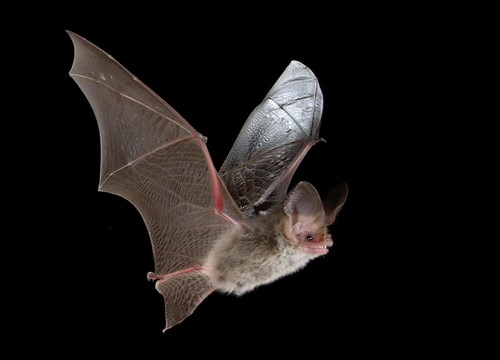Nyctophilus
Nyctophilus gouldii
The Australian long-eared bats ( Nyctophilinae ) are a bat group from the family of Myotis bats ( Vespertilionidae ). In this group, about twelve species from two genera, Nyctophilus and Pharotis be summarized that live in Australia, New Guinea and New Caledonia. One or two species are extinct but.
Description
Of all the other Myotis bats, these animals differ by a small nose leaf, which sits on the cut -acting snout. The ears are long and grown together at the base. The coloring of their fur varies from orange to light brown to gray. With a body length 38-75 mm and a weight of 4 to 20 grams, they are among the small to medium sized species.
Way of life
These animals inhabit a range of habitats, including forests, bush -lined areas and deserts. As Sleeps serve them caves, crevices and tree cavities, sometimes building. You sleep alone, in pairs or in small groups, as most bats are nocturnal. At night, they go in search of food, where their flight is described as slow and fluttery. Their diet consists of insects, which they capture either in flight or pick up of leaves. In the cooler regions of their range they are hibernating.
Little is known about reproduction in species that hibernate, mating occurs often in the fall, but it only comes in the spring for fertilization. The Birth of usually two cubs falls late in the spring or summer.
Systematics and species
In some classifications, the Australian long-eared bats as a separate subfamily, Nyctophilinae, out, in others they are associated with actual Myotis bats ( Vespertilioninae ). You are likely to be closely related to the Antrozoinae.
There are two genera, Nyctophilus and Pharotis, with about 12 species, including one or two extinct distinguished:
- Nyctophilus arnhemensis is located in northern Western Australia and the Northern Territory.
- Nyctophilus bifax lives in New Guinea and northern Australia.
- Nyctophilus geoffroyi is widespread throughout Australia.
- Nyctophilus gouldii is native throughout Southern Australia.
- Nyctophilus zoom is on the island Lembata that part of the Lesser Sunda Islands, endemic. The species is considered threatened.
- Nyctophilus howensis came earlier before on Lord Howe Island, but is probably extinct by the year 1500.
- Nyctophilus microdon lives in eastern New Guinea.
- Nyctophilus Microtis is also native to New Guinea.
- Nyctophilus nebulosus was only discovered in the 1990s. The species lives in New Caledonia.
- Nyctophilus timoriensis lives in Australia, New Guinea and possibly also on Timor.
- Nyctophilus walkeri lives in northern Western Australia and the Northern Territory.
- Pharotis imogene lives in southeastern New Guinea, the species was, however, not been sighted since 1890 and is possibly already extinct, the IUCN lists them as a serious threat.


_(8656886333).jpg)






